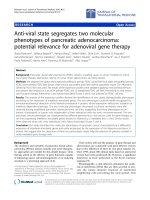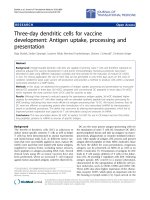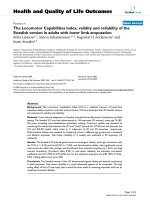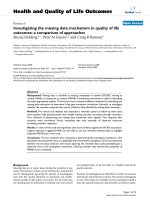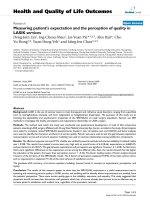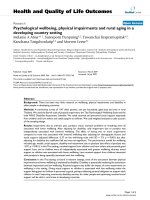Báo cáo hóa học: " Rolled-Up Nanotech: Illumination-Controlled Hydrofluoric Acid Etching of AlAs Sacrificial Layers" pot
Bạn đang xem bản rút gọn của tài liệu. Xem và tải ngay bản đầy đủ của tài liệu tại đây (335.67 KB, 6 trang )
NANO EXPRESS
Rolled-Up Nanotech: Illumination-Controlled Hydrofluoric
Acid Etching of AlAs Sacrificial Layers
Ruxandra M. Costescu Æ Christoph Deneke Æ
Dominic J. Thurmer Æ Oliver G. Schmidt
Received: 2 June 2009 / Accepted: 14 August 2009 /Published online: 3 September 2009
Ó to the authors 2009
Abstract The effect of illumination on the hydrofluoric
acid etching of AlAs sacrificial layers with systematically
varied thicknesses in order to release and roll up InGaAs/
GaAs bilayers was studied. For thicknesses of AlAs below
10 nm, there were two etching regimes for the area under
illumination: one at low illumination intensities, in which
the etching and releasing proceeds as expected and one at
higher intensities in which the etching and any releasing
are completely suppressed. The ‘‘etch suppression’’ area is
well defined by the illumination spot, a feature that can be
used to create heterogeneously etched regions with a high
degree of control, shown here on patterned samples.
Together with the studied self-limitation effect, the tech-
nique offers a way to determine the position of rolled-up
micro- and nanotubes independently from the predefined
lithographic pattern.
Keywords Rolled-up Á Nanotubes Á Nanotech Á
Nanostructures Á Etching Á Hydrofluoric acid Á III–V layers Á
Illumination-controlled
Introduction and Background
Rolled-up nanotech [1, 2] has become a powerful tech-
nology with applications in a broad range of research fields,
including optofluidics [3], micromachinery [4–6], mag-
netofluidics [4, 7], biophysics [4, 8], nanomechanics [9],
and waveguiding for different spectral ranges and
applications [10–12]. Large arrays of periodically ordered
microtubes can be fabricated by a combination of lithog-
raphy and deliberate self-rolling of strained layers upon
selective underetching [1, 13–15]. However, in some cases,
it might be important to stimulate tube formation in certain
areas and suppress tube formation outside those areas.
Precise control over the lateral positioning and the number
of windings is fundamental for the use of the tubes in
optical resonators for sensors [16–20], hyperlenses [4, 21,
22], or electrical transport (curved electron gases) [23–27].
Numerous existing studies offer highly sophisticated
methods for precise lateral positioning of rolled-up semi-
conductor nanostructures by controlling the starting edges
[13–15, 28, 29], but difficulties arise for thin layers due to
the extensive, successive lithography steps involved, and
ways to control the stopping point of rolling remain largely
lacking without modifying the structure.
Here, we demonstrate illumination-controlled hydroflu-
oric acid (HF) etching of a buried thin AlAs sacrificial
layer. Sufficiently intense light exposure of a certain sub-
strate area leads to a complete suppression of the under-
etching effect, and as a result, the formation of rolled-up
InGaAs/GaAs tubes can be easily controlled spatially. This
method allows for control over the roll-up stopping point
and is suitable for very thin sacrificial layers.
The aim of this study was to quantify the observed
‘‘etch-suppression effect’’ (ESE) and precisely control the
release of InGaAs/GaAs bilayers with an illumination
technique.
Experimental Details
Figure 1a shows schematically the formation process of a
III–V rolled-up nanotube (RUNT): when immersed in HF
R. M. Costescu (&) Á C. Deneke Á D. J. Thurmer Á
O. G. Schmidt
Institute for Integrative Nanosciences, IFW Dresden,
Helmholtzstr. 20, 01069 Dresden, Germany
e-mail:
123
Nanoscale Res Lett (2009) 4:1463–1468
DOI 10.1007/s11671-009-9421-8
solution, the compressively strained double layer (a GaAs
layer on top of a larger-lattice constant In
x
Ga
1-x
As layer
deposited pseudomorphically on a GaAs substrate with an
AlAs sacrificial layer) releases from the substrate as the
sacrificial layer is preferentially removed by the HF at a
previously defined starting edge and begins to roll up in
order to relax the built-in strain gradient. Finally, the bent
bilayer forms a tube or scroll after performing a full rota-
tion. The starting edge, which for InGaAs/GaAs layers
should be oriented in the [100] direction for optimal
structural integrity of the resulting RUNTs [29, 30], can be
defined either by scratching the surface, thereby laterally
exposing the sacrificial layer, or by opening a window
through the entire layer structure by photolithography and
subsequent wet chemical etching. The tube diameter, i.e.,
the size of the cross section of the structure obtained after
the etching step has been completed, depends on the
thickness and inherent strain of the layers, and can be
accurately varied in the nano- to micrometer range [1, 30,
31, 32]. For precise positioning of RUNTs on the surface,
the important parameters in the roll-up process are the
sacrificial layer thickness, etching time, and tube diameter
[30]. The ratio of inner-to-outer diameter can also be
controlled over a wide range, based on the number of
rotations performed by the tubes on the surface (or rolling
distance, measured from the initial starting edge—see
schematic in Fig. 1a, step 3 and Fig. 3, inset) [30].
Here, the experiments were performed using 20 nm
In
0.33
Ga
0.66
As/20 nm GaAs structures on AlAs grown on
(001) GaAs substrates by molecular beam epitaxy, where
the thickness of the AlAs was varied from 4 to 20 nm. For
experiments pertaining to the measurement of the onset of
the etch suppression and rolling distance, the starting edges
were defined by mechanical scratching, whereas photoli-
thography and wet chemical etching (by H
3
PO
4
:H
2
O
2
:H
2
O
solution) were used for controlling the etch suppression.
Our specially designed setup involved an HF-resistant
trough for etching with HF under light focused by a Zeiss
optical microscope using different objective lenses of 5 9
through 50 9 magnification (for sample evolution during
this process, see Fig. 1a and b). Other measurements were
performed using illumination from a HeNe laser with
maximum output power of 2 mW, as well as a laser with
adjustable power (up to 20 mW) and wavelength (535–
825 nm) with focusing optics or an optical fiber to illu-
minate the surface of the sample. For all measurements, the
intensity of illumination was measured beforehand using a
calibrated power meter. For samples that were etched,
illuminated, and observed under the microscope, the set-
tings on the illumination dial were used and the focused
spot sizes for each magnification were assumed to be the
same. For the quantitative measurements of tube rolling
distance, optical images of the sample outside of solution
once the etching was terminated were taken. From these
Fig. 1 a Steps of strained
bilayer roll-up process (1. initial
strained bilayer/sacrificial layer/
substrate structure with defined
starting edge, 2. bilayer rolling
due to sacrificial layer removal
in HF, 3. rolled-up structure
after one full rotation). b
Schematic of the etching
experiment during in situ
observation by optical
microscopy and result for
strained bilayers (relative ratio
of mesa diameter to layer
thickness not to size). c Optical
image of an AlAs/InGaAs/GaAs
mesa structure etched in a 2.5%
HF solution, with 20 9
microscope objective, for
6 min; the etch-suppression spot
radius is *700 lm. d Optical
images of adjacent mesas from
(b)(black box), showing an
increasing degree of etch
suppression toward the center of
the illumination
1464 Nanoscale Res Lett (2009) 4:1463–1468
123
images, the rolling distance could then be measured, which
we define as distance from the starting edge to the center of
the tube width, assumed to correspond to the stopping point
of the underetching.
The resolution of the ES method was studied by pre-
cisely positioning the illumination spot on wet-chemically
etched mesa structures of different shapes and sizes (on the
order of 10–100 lm) during HF etching. The degree of
etching suppression (given by the coverage area of unet-
ched structures remaining on the sample) was measured
versus distance from the center of illumination.
Results
Characteristics of Etching Suppression Effect
Figure 1b shows an optical microscopy image of a struc-
ture composed of a 4 nm AlAs layer and a 40 nm sym-
metrical strained In
0.33
Ga
0.66
As/GaAs bilayer. The larger
circular shape observed on the sample at the end of the HF
experiment is formed by original mesa structures that were
left unetched, while on the rest of the sample the bilayer
mesas are underetched, leading to rolling up as expected.
Figure 2, which plots the average rolling distance as a
function of intensity for structures with varying AlAs
thickness, illustrates the sudden onset of the ESE. The error
due to variations in experimental parameters such as
quantity of HF solution, scattering of light and effective
illumination intensity at the sample, as well as the method
for evaluating rolling distances, is estimated to be within
15%. It can be seen that the maximum rolling distance
increases as the AlAs thickness increases, while the ESE is
only present for sacrificial layers below 10 nm. Moreover,
the onset of the ESE, or the intensity of illumination nec-
essary to suppress the AlAs etching, is higher for larger
thicknesses.
Figure 3 shows the maximum rolling distance as a
function of the sacrificial layer thickness. In a regime from
5 nm up to a thickness of 15 nm of AlAs the relationship
between the maximum rolling distance and the sacrificial
layer thickness is approximately linear, and then saturates
for thicker AlAs layers. Although in previous studies [14,
30] InGaAs-GaAs RUNTs (rolled-up nanotubes) have been
noticed to exhibit a self-limiting rolling behavior for longer
etching times, this limiting was not investigated as function
of the sacrificial layer thickness. The fit through the data in
the linear increase regime (R
2
= 0.936) yields a unitless
slope of 14.2e
3
for the scaling of maximum rolling distance
with t
AlAs
. This indicates that in this first regime the
maximum rolling distance is not dominated by intrinsic
effects of the rolled-up layer and does not occur due to
a fundamental limiting process (as, e.g., described by
Cendula et. al. [33]). Therefore, we ascribe the saturation in
this regime to dynamic effects either between the rolled-up
layer and the substrate or inside the etching solution caused
by the process in the gap between the substrate and the
rolled-up film. The second regime shows a clear saturation
behavior for AlAs thickness larger than 15 nm. In this
Fig. 2 Onset of illumination effect for 20 nm InGaAs/20 nm GaAs
samples with 4, 7, 10, 12, 13, 15, and 20 nm AlAs sacrificial layers,
etched with 2.5% HF solution using 20 9 microscope objective, for
8 min; the starting edges were produced by mechanical scratching.
The diamond data point shows a maximum rolling distance
previously reported [14]
Fig. 3 Maximum rolling distance versus various AlAs thicknesses
(same parameters as in Fig. 2); the starting edges were produced by
mechanical scratching. The line through the data in the linear increase
regime is a best fit. The inset shows a cross section of step 2 in
Fig. 1a, indicating rolling distance d
roll
measured from the starting
edge, AlAs thickness t
AlAs
, InGaAs/GaAs bilayer thickness t
bil.
, and
radius of curvature R of the rolled-up bilayer
Nanoscale Res Lett (2009) 4:1463–1468 1465
123
regime, the saturation should be dominated by intrinsic
effects either from the layer system itself or possibly by
some kind of fundamental process yet to be found. The
linear scaling of the maximum rolling distance offers the
possibility for lateral positioning of the rolled-up tube
relative to a defined starting edge [14].
Furthermore, as shown in Fig. 4, the onset of ESE
changes for different etching speeds: the higher the HF
concentration, the higher the intensity needed for sup-
pression, while the thicker the AlAs layer, the more abrupt
the etching behavior transition from the ‘‘suppression
regime’’ to the ‘‘illumination independent regime.’’ For
each t
AlAs
, up to roughly 15 nm the onset of the ESE
increases approximately linearly with concentration, and
scaling slopes are comparable for different thicknesses
(&12 mW/mm
2
). From this, as well as Fig. 2, it can be
concluded that the onset of ESE occurs in a different
regime from that of intrinsic saturation of maximum rolling
distance.
We also found that the ESE is time dependent, i.e., the
etching time under illumination determines whether further
etching will continue once the illumination is removed. In
our experiments, we found that for samples where the high
intensity light exposure was kept short, the layers were able
to start rolling after being removed from the light source.
This effect was found to not only depend on the light
intensity but also on the thickness of the AlAs layer, which
suggests that the etch suppression is a dynamic process that
depends on the access of HF to the AlAs layer and the
exchange of products and reactants in this region. This
conclusion is further corroborated by the fact that with
increasing AlAs thickness the rolling distance of the
strained bilayer becomes independent of the AlAs gap size
(Fig. 3).
Using Etch Suppression for Nanotube Positioning
The ESE was used to position and control the roll up of
tubes from strained InGaAs/GaAs bilayers. The patterning
allowed us to create well-defined starting edges suitable for
the illumination experiment (as in Fig. 1). By cleverly
integrating this process, one can obtain both etched regions
with rolled-up layers and unetched regions within a small
area on the sample. Furthermore, this technique is useful
for applications since, during the ES, the structures remain
unchanged other than the ‘‘blocking’’ at the starting edge.
The resolution of this method is indicated by Fig. 5,
which is a plot of the degree of etching/suppression versus
the distance from the center of the illumination for the 80-
lm diameter pattern shown in Fig. 1. The ‘‘degree of etch
suppression’’ is the percentage of the circular mesa surface,
which appears intact in optical images of the etched
structures (see Fig. 1d). As can be seen from this plot, the
length scale on which the ESE transitions from ‘‘no sig-
nificant suppression’’ to ‘‘full suppression’’ is *100 lm.
Further refinement is possible either using smaller illumi-
nation areas, restricting light access close to the surface of
the samples (for instance, by a shadow mask placed
directly above the sample in the solution) or developing
Fig. 4 The onset of the etch-suppression effect (ESE) versus HF
concentration for 20 nm InGaAs/20 nm GaAs structures with 4 nm
and 10 nm AlAs sacrificial layers, with 20 9 microscope objective,
for 8 min; the starting edges were produced by mechanical scratching.
The lines through the data are guides for the eye
Fig. 5 ‘‘Degree of suppression’’ (% of area) versus distance from the
center of the illumination for the sample in Fig. 1. The grey areas
indicate a fit based on the average degree of suppression and standard
deviation values, for all points below and above a distance of 850 lm,
differentiating the regimes with ESE and no significant ESE,
respectively
1466 Nanoscale Res Lett (2009) 4:1463–1468
123
methods to reduce stray light and diffraction in the
solution.
Discussion, Uncertainties, and Limitations
We investigated the rolling distance as a function of illu-
mination intensity used during the HF etching of AlAs/
InGaAs/GaAs structures on GaAs for different sacrificial
layer thicknesses. For AlAs layers thinner than 10 nm, total
suppression of the etching process occurs beyond a
threshold intensity that increases with increasing AlAs
thickness.
The ESE is clearly influenced by the AlAs-HF reaction
rate as well as the physical characteristics of the structure:
the larger the sacrificial layer gap and faster the reaction
rate, the higher the intensity of illumination needed to
suppress the etching. This trend continues up to a point
where the reaction is no longer illumination dependent and
suppression is no longer possible. A further series of
experiments involving etching with filtered light and a
focused laser beam of varying wavelengths (not presented
here) suggests that the ESE is preserved for lower energies
than the AlAs band gap and therefore any photochemical
effect in HF cannot depend on light excitation of the AlAs
material. We have also eliminated the possibility that
heating plays a significant role in the ESE, since experi-
ments that involve heating samples in HF solution past the
boiling point show an enhancement rather than suppression
of the etching and hence would counteract this effect.
We believe that for the ESE found in samples etched
with HF for shorter times under illumination levels close to
the threshold value from Fig. 2, the strained bilayer
remains intact because the sacrificial layer was not under-
etched at the starting edge, which may happen through the
accumulation of solid As and As oxide following from a
photochemical interaction at the GaAs surface in the
presence of HF.
The process through which AlAs sacrificial layers are
wet-etched with hydrofluoric acid (HF) [34–43] as well as
the laser-induced etching of semiconductors by a dilute
acid solution [44–46] have been investigated previously in
some depth. In HF-AlAs reactions, any passivating As
formed at the surface is usually oxidized and then dis-
solved, thus allowing new access to the etch front and
sustaining etching [34]. But if the rate of As production
exceeds that of oxide formation, or if the type of oxide is
stable in the HF, then the etching will be inhibited. From
laser-induced etching studies, it is clear that porous stable
oxide films formed at the semiconductor surface give a
time dependence for the process [46]. During the redox
reaction, As(III) must be complexed by water and dis-
solved as HAsO
2
and As
2
O
3
, but when the concentration of
As(III) surpasses the solubility limit, there is precipitation
of As at the surface, slowing down the reaction. Our results
match well with this type of process, and we propose that
the ESE occurs in a similar fashion: the formation of very
small amounts of As or As
2
O
3
at the AlAs gap, which
would nonetheless be enough to block access of HF to
films under 10 nm, can effectively suppress the underet-
ching of the AlAs layer. In accordance with our findings,
the thicker the sacrificial layer gap and the faster the HF
etching rate, the less likely the ESE takes place. In the
suppression regime for thinner AlAs layers, for higher
intensities of illumination the photogeneration of holes is
more pronounced leading to a faster subsequent passivation
(and reaching of the ESE limit with time). For thicker AlAs
layers, higher illumination can still lead to changes at the
GaAs substrate interface [46] but does not hinder the
etching of the AlAs.
Conclusion
While the self-limitation of the maximum rolling distance
of RUNTs allows for the precise tuning of the number of
rotations as a function of the sacrificial layer, the illumi-
nation permits the exact positioning of the tube in combi-
nation with common lithographic technology. Fine-tuning
the etch suppression with patterned samples can yield a
useful way of precisely controlling the roll up of strained
InGaAs/GaAs bilayers and the entire tube fabrication
process, as well as other more general laser-assisted
microfabrication applications, with a convenient, custom-
izable method. In this way, it is complementary to pre-
pattering of the sample by lithographic means and allows
for a full control over the position of the produced RUNTs.
Acknowledgments The authors would like to thank Emica Coric,
Dr. Stefan Baunack, Dr. Jurgen Thomas, and Dr. Ingolf Monch for
processing and characterization help, and Dr. Armando Rastelli and
Dr. Francesca Cavallo for fruitful discussions.
References
1. V.Ya. Prinz, V.A. Seleznev, A.K. Gutakovsky, A.V. Chehovskiy,
V.V. Preobrazhenskii, M.A. Putyato, T.A. Gavrilova, Physica E
6(1–4), 828–831 (2000)
2. O.G. Schmidt, K. Eberl, Nature 410(6825), 168 (2001)
3. A. Bernardi, S. Kiravittaya, A. Rastelli, R. Songmuang, D.J.
Thurmer, M. Benyoucef, O.G. Schmidt, Appl. Phys. Lett. 93
094106 (2008)
4. Y. Mei, G. Huang, A.A. Solovev, E. B. Urena, I. Mo
¨
nch, F. Ding,
T. Reindl, R.K.Y. Fu, P.K. Chu, O.G. Schmidt, Adv. Mat. 20(21),
4085–4090 (2008)
5. L. Zhang, J.A. Abbott, L. Dong, B.E. Kratochvil, D. Bell, B.J.
Nelson, Appl. Phys. Lett. 94, 064107 (2009)
6. A.A. Solovev, Y. Mei, E. Bermudez Urena, G. Huang, O.G.
Schmidt, Small, 5, 1688 (2009)
Nanoscale Res Lett (2009) 4:1463–1468 1467
123
7. E. Bermudez, Y. Mei, E. Coric, D. Makarov, M. Albrecht, O.G.
Schmidt, J. Phys. D: Appl. Phys. 42(5), 4085–4090 (2009)
8. G. Huang, Y. Mei, D.J. Thurmer, E. Coric, O.G. Schmidt, Lab
Chip 9, 263–268 (2009)
9. L. Zhang, L. Dong, B.J. Nelson, Appl. Phys. Lett. 92, 243102
(2008)
10. S. Mendach, R. Songmuang, S. Kiravittaya, A. Rastelli,
M. Benyoucef, O.G. Schmidt, Appl. Phys. Lett. 88, 111120 (2006)
11. Ch. Deneke, O.G. Schmidt, Appl. Phys. Lett. 89, 123121 (2006)
12. E.J. Smith, Z. Liu, Y. Mei, O.G. Schmidt, Nano Lett. (2009)
doi:10.1021/nl900550j
13. A.B. Vorob’ev, V.Ya. Prinz, Semicond. Sci. Technol. 17, 614–
616 (2002)
14. C. Deneke, O.G. Schmidt, Appl. Phys. Lett. 85, 2914 (2004)
15. X. Li, J. Phys. D: Appl. Phys. 41, 193001 (2008)
16. T. Kipp, H. Welsch, Ch. Strelow, Ch. Heyn, D. Heitmann, Phys.
Rev. Lett. 96, 077403 (2006)
17. S. Mendach, S. Kiravittaya, A. Rastelli, M. Benyoucef,
R. Songmuang, O.G. Schmidt, Phys. Rev. B 78, 035317 (2008)
18. Ch. Strelow, H. Rehberg, C.M. Schultz, H. Welsch, Ch. Heyn,
D. Heitmann, T. Kipp, Phys. Rev. Lett. 101, 127403 (2008)
19. R. Songmuang, A. Rastelli, S. Mendach, T. Shigaki, Appl. Phys.
Lett. 90, 091905 (2007)
20. M. Hosoda, T. Shigaki, Appl. Phys. Lett. 90, 181107 (2007)
21. S. Schwaiger, M. Broll, A. Krohn, A. Stemmann, C. Heyn,
Y. Stark, D. Stickler, D. Heitmann, S. Mendach, Phys. Rev. Lett.,
102, 163903 (2009)
22. E.J. Smith, Z. Liu, Y.F. Mei, O.G. Schmidt, Appl. Phys. Lett.,
(2009, in press)
23. K.J. Friedland, R. Hey, H. Kostial, A. Riedel, K.H. Ploog, Phys.
Rev. B 75, 045426 (2007)
24. A.B. Vorob’ev, K.J. Friedland, H. Kostial, R. Hey, U. Jahn,
E. Wiebicke, J.S. Yukecheva, V.Ya. Prinz, Phys. Rev. B 75,
205309 (2007)
25. A.B. Vorob’ev, V.Ya. Prinz, J.S. Yukecheva, A.I. Toropov,
Physica E 75(1–2), 171–176 (2004)
26. K.J. Friedland, A. Siddiki, R. Hey, H. Kostial, A. Riedel, D. K.
Maude, Phys. Rev. B 79, 125320 (2009)
27. S. Mendach, O. Schumacher, H. Welsch, C. Heyn, W. Hansen,
M. Holz, Appl. Phys. Lett. 88, 212113 (2006)
28. V.Ya. Prinz, Microelectron. Eng. 69, 466475 (2003)
29. V.Ya. Prinz, Physica E 23, 260–268 (2004)
30. C. Deneke, O.G. Schmidt, Physica E 23, 269–273 (2004)
31. C. Deneke, C.M. Muller, N.Y. Phillipp, O.G. Schmidt, Semicond.
Sci. Technol. 17, 1278 (2002)
32. O.G. Schmidt, C. Deneke, Y. Manz, C. Muller, Physica E 13, 969
(2002)
33. P. Cendula, S. Kiravittaya, Y.F. Mei, Ch. Deneke, O.G. Schmidt,
Phys. Rev. B 79, 085429 (2009)
34. M.M.A.J. Voncken, J.J. Schermer, A.T.J. van Niftrik, G.J.
Bauhuis, P. Mulder, P.K. Larsen, T.P.J. Peters, B. de Bruin,
A. Klaassen, J.J. Kelly, J. Electrochem. Soc. 151
(5), G347–G352
(2004)
35. M.M.A.J. Voncken, J.J. Schermer, G.J. Bauhuis, A.T.J. van
Niftrik, P.K. Larsen, J. Phys.: Cond. Matt. 16(21), 3585–3596
(2004)
36. A.T.J. van Niftrik, J.J. Schermer, G.J. Bauhuis, P. Mulder,
P.K. Larsen, J.J. Kelly, J. Electrochem. Soc. 154(11), D629–
D635 (2007)
37. R.A. Logan, F.K. Reinhart, J. Appl. Phys. 44, 4172–4176 (1973)
38. J.J. Schermer, G.J. Bauhuis, P. Mulder, W.J. Meulemeesters,
E. Haverkamp, M.M.A.J. Voncken, P.K. Larsen, Appl. Phys. Lett
76(15), 2131–2133 (2000)
39. E. Yablonovitch, T. Gmitter, J.P. Harbison, R. Bhat, Appl. Phys.
Lett. 51(26), 2222–2224 (1987)
40. J I. Maeda, Y. Sasaki, N.N. Dietz, K. Shibahara, S. Yokoyama,
S. Miyazaki, M T. Hirose, Jpn. J. Appl. Phys. 36, 1554–1557
(1997)
41. Y. Sasaki, T. Katayama, T. Koishi, K. Shibahara, S. Yokoyama,
S. Miyazaki, M. Hirose, J. Electrochem. Soc. 146(2), 710–712
(1999)
42. M.M.A.J. Voncken, J.J. Schermer, G. Maduro, G.J. Bauhuis,
P. Mulder, P.K. Larsen, Mat. Sci. Eng. B95, 242–248 (2002)
43. K.S.R.K. Rao, T. Katayama, S. Yokoyama, M. Hirose, Jpn. J.
Appl. Phys. 39, L457–L459 (2002)
44. L. Hollan, R. Memming, J.C. Tranchart, J. Eletrochem. Soc. 126,
855 (1979)
45. H.S. Mavi, S.S. Islam, S. Rath, B.S. Chauhan, A.K. Shukla, Mat.
Chem. Phys. 86, 414–419 (2004)
46. B. Joshi, S.S. Islam, H.S. Mavi, V. Kumari, T. Islam,
A.K. Shukla, Harsh, Physica E 41(4), 690–694 (2009)
1468 Nanoscale Res Lett (2009) 4:1463–1468
123


